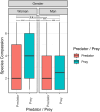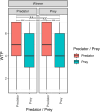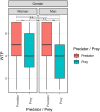The effect of fear and compassion on human willingness to protect predators and prey
- PMID: 40603442
- PMCID: PMC12222914
- DOI: 10.1038/s41598-025-06861-6
The effect of fear and compassion on human willingness to protect predators and prey
Abstract
Human perception of predators is extremely important because the decline in biodiversity requires greater involvement from the public in species conservation. We conducted an online study in Slovakia with 225 adult participants (151 women; mean age = 24 years), who viewed a series of short videos depicting predator-prey interactions in which the predator either won or lost the encounter. Most of the predators depicted were large mammals (e.g., leopards, lions), one of which was a snake. We examined participants' compassion towards both the predator and prey and their willingness to protect these species. Participants exhibited greater compassion towards predators when they lost, whereas prey received higher compassion scores when they lost than when they won. Prey generally received higher compassion scores than predators. Fear of perceived animals was negatively correlated with compassion for predators and prey. Perceived fear and compassion for both predators and prey were positively correlated with the willingness to protect them (WTP), although these correlations were negative for the majority of predator species. WTP was not significantly influenced by the outcome of the encounter. Snakes, often considered prototypical stimuli for human fear, elicited less compassion and lower WTP compared to mammalian predators. We conclude that human sensitivity to physical interactions between predators and prey does not necessarily translate into a willingness to protect these animals. Conservation strategies need to consider the emotional and cognitive biases people hold toward different species. By acknowledging these biases, especially fear and perceived charisma, conservation campaigns may more effectively foster public support for protecting a broader range of species.
Keywords: Animal cruelty; Emotions toward animals; Perception of predators.
© 2025. The Author(s).
Conflict of interest statement
Declarations. Competing interests: The authors declare no competing interests. Ethics declarations: This research was approved by the ethics committee of the Faculty of Natural Sciences, Comenius University (Licence no. ECH19036). All methods were performed in accordance with the relevant guidelines and regulations, including the Declaration of Helsinki. Informed consent was obtained from all participants involved in the study.
Figures






References
-
- Hart, D. & Sussman, R. W. in Man the Hunted: Primates, Predators, and Human Evolution. (eds Hard, D. & Sussman, R. W.) (Westview, 2008). 357 pp
-
- Isbell, L. A. The Fruit, the Tree, and the Serpent: why We See so Well (Harvard University Press, 2009).
-
- Barrett, H. C. Adaptations to predators and prey. In The Handbook of Evolutionary Psychology (ed. Buss, D. M.) 200–223 (John Wiley & Sons Inc, 2015).
-
- Treves, A. & Palmqvist, P. Reconstructing hominin interactions with mammalian carnivores. In Primate Anti-Predator Strategies (eds Gursky, S. L. & Nekaris, K. A. I.) 355–381 (Springer, 2007).
MeSH terms
Grants and funding
LinkOut - more resources
Full Text Sources

